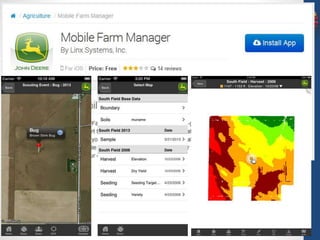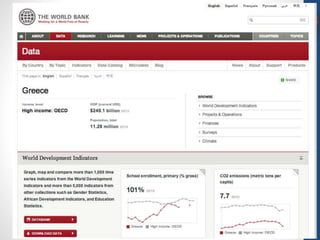Introduction to Agriculture & Food Safety Data
- 1. Introduction to Agriculture & Food Safety Data Vassilis Protonotarios Agro-Know 2ndSemaGrowHackathon(inconjunctionwithIRSS14) supported by:
- 2. Intro to the intro This presentation aims to: • Provide basic information regarding the various sources of agricultural and food safety data • ranging from definitions to actual data sources, data types and attributes • Highlight issues related to the management and use of this kind of data and possible solutions and ideas for the exploitation of such data 2 2ndSemaGrowHackathon(inconjunctionwithIRSS14)
- 4. Agricultureisabouttoexperiencea“growthshock” inordertocovertheexponentiallyincreasingfood needsoftheglobalpopulation • All demographic and food demand projections suggest that, by 2050, the planet will face severe food crises due to our inability to meet agricultural demand – by 2050: • 9.3 billion global population, 34% higher than today • 70% of the world’s population will be urban, compared to 49% today • food production (net of food used for biofuels) must increase by 70% • According to these projections, and in order to achieve the forecasted food levels by 2050, a total investment of USD 83 billion per annum will be required • A large part of this investment will need to be focused on R&D 4 2ndSemaGrowHackathon(inconjunctionwith IRSS14) Key facts about agricultural trends
- 5. Oneofthemostpromisingroutestoagriculture modernisationistheprovisionofOpenDatatoall interestedparties • In an era of Big Data, one of the most promising routes to achieve R&D excellence in agriculture is Open Data, and in particular: • provisioning, • maintaining, • enriching with relevant metadata and • making openly available a vast amount of open agricultural data • The use and wide dissemination of these data sets is strongly advocated by a number of global and national policy makers such as: • The New Alliance for Food Security and Nutrition G-8 initiative • FAO of the UN • DEFRA & DFID in UK • USDA & USAID in the US 5 2ndSemaGrowHackathon(inconjunctionwith IRSS14) Open Data in Agriculture
- 7. open: definition “Open data is data that can be freely used, reused and redistributed by anyone - subject only, at most, to the requirement to attribute and sharealike” 7 2ndSemaGrowHackathon(inconjunctionwith IRSS14)
- 8. Why open data? • Open data, especially open government data, is a tremendous resource that is as yet largely untapped • individuals and organisations collect broad range of different types of data to perform their tasks • Government is particularly significant in this respect • quantity and centrality of data it collects • most is public data by law, could be made open and made available for others to use 8 2ndSemaGrowHackathon(inconjunctionwith IRSS14)
- 10. in agriculture: a political priority “How Open Data can be harnessed to help meet the challenge of sustainably feeding nine billion people by 2050” 29-30/4/2013, Washington D.C., USA https://sites.google.com/site/g8openda taconference/home
- 13. biodiversity
- 14. examples of variety & diversity
- 15. data sets
- 16. maps
- 17. photos
- 18. databases
- 19. • publications, theses, reports, other grey literature • educational material and content, courseware • primary data, such as measurements & observations • structured, e.g. datasets as tables • digitized, e.g. images, videos • secondary data, such as processed elaborations • e.g. dendrograms, pie charts, models • provenance information, incl. authors, their organizations and projects • experimental protocols & methods • social data, tags, ratings, etc. • … research(+) content
- 20. where can I find this data?
- 27. Where to use this data?
- 33. there is more…
- 34. …and more…
- 35. …and much much more
- 37. About food (safety) data
- 39. Data sources
- 41. Data sources
- 45. Using open data & knowledge sharing in agro-food sector
- 46. using open data to build an open and scalable infrastructure for food safety
- 47. usingopendata to supportdecisionmakingfor regional growth browse agricultural resources and activities by geographical region to understand opportunities for grows at regional level
- 48. using open educational data to support training on organic agricultural localize to specific region by adapting content and using state of art language technologies
- 49. localizing open educational data to train the trainers
- 50. organizingevents to spurinnovation challenges creativity excellencehack using open data
- 51. transferring innovation to the regional ecosystem collaboration with stevianet.gr experiment citytofarm.grplatform for ag-machinery sharing
- 53. How to get this data? • APIs • SPARQL endpoints • OAI-PMH (for metadata) • HTML / data scraping • ………
- 54. so, what’s the catch?
- 55. open data is not always ready to be used…. • Messy data • Should be collected/fused • Should be filtered • Should be validated • Should be enriched with metadata to become discoverable • Should be standardized to allow interoperability
- 56. plug and play? •No! • requires a deep understanding of the data • requires excellent data processing & analysis skills • requires very good technical skills • will evolve into a data-powered value chain • the companies that develop innovative agro/ food products (agro apps consumers) need… • …companies that build apps on agro data (agro data consumers, agro apps producers) who need… • companies that process agro data (data science powered)
Editor's Notes
- Statistical Service (http://www.mof.gov.cy/mof/cystat/statistics.nsf/agriculture_51main_gr/agriculture_51main_gr?OpenForm&sub=1&sel=2)
- http://www.foodsafetynews.com/sections/food-recalls/#.U7P55vmSzSg
- http://cspinet.org/foodsafety/outbreak/pathogen.php#
- http://www.outbreakdatabase.com/

























































